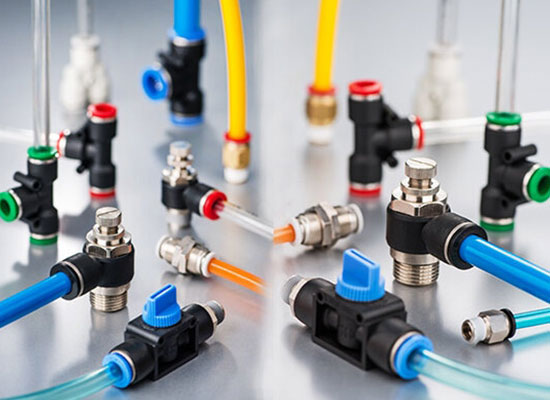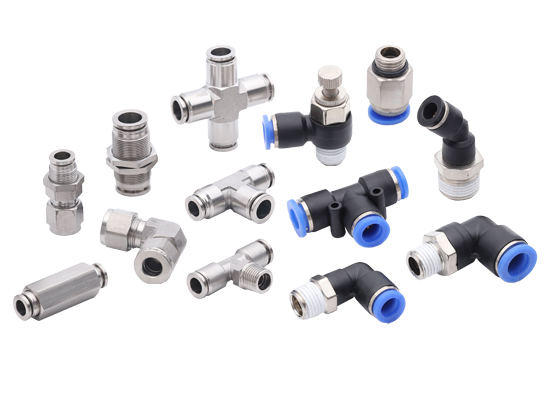- sales@fokca.com info@fokca.com
- WhatsApp: +86 150 5749 1870

Pneumatic push-in fittings, also known as push to connect fittings or push lock fittings, are essential components in pneumatic systems.
Pneumatic Push-In Fittings are designed to quickly and easily connect pneumatic tubes or hoses to other components in the system without the need for special tools. Pneumatic push to connect fittings are commonly used in a variety of applications such as automation, control systems, air compressors, and more.
These fittings offer quick, reliable connections, providing a cost-effective solution to many industrial needs.

The working principle of pneumatic push-in fittings revolves around the mechanism that securely locks the hose or tube into place.
When a hose or tube is pushed into the fitting, a built-in collet (gripping mechanism) inside the fitting tightly holds the tube in place.
This mechanism allows the fitting to seal the connection and ensures the flow of compressed air is maintained.
The locking action ensures a secure and leak-free connection, even when subjected to pressure fluctuations.
Push to connect fittings are engineered to make assembly and disassembly quick and easy. To remove a tube, users simply press a release collar on the fitting,
which releases the collet and allows the tube to be pulled out, without the need for tools.
or tubes in a pneumatic system. They are designed to handle compressed air and ensure that the air flow is uninterrupted and efficient.
◆ Quick and Easy Assembly: One of the main advantages of pneumatic fittings push to connect systems is their simplicity and ease of installation.
This significantly reduces downtime during maintenance or installation compared to traditional threaded fittings.
◆ Versatility: These fittings can be used in a variety of applications, from pneumatic hoses and fittings to industrial systems requiring high-pressure air delivery.
They are suitable for both high-flow pneumatic systems and more compact setups where space is a premium.
◆ Cost-Effective: The ease of installation and the fact that they eliminate the need for specialized tools make push-in fittings cost-effective for both assembly and maintenance.
◆ Flexible and Reliable: Pneumatic quick-connect fittings allow for fast connection and disconnection, enhancing flexibility, especially in systems where frequent changes are needed.
Pneumatic push-in fittings are typically constructed from a variety of materials, chosen based on the environment and pressure conditions they will operate under. The Common materials include:
◆ Plastic: Often used for light-duty applications, such as in small-scale pneumatic systems or low-pressure environments.
Materials such as polyamide (PA), acetal (POM), and polypropylene (PP) are popular choices because of their corrosion resistance and low weight.
◆ Brass: Brass fittings are commonly used for moderate pressure systems and provide a balance of durability and cost.
Brass is resistant to rust and is ideal for environments with moderate moisture or corrosive elements.
◆ Stainless Steel: Stainless steel push-in fittings are used in high-pressure or corrosive environments. Stainless steel is highly resistant to rust and corrosion,
making it an ideal choice for harsh industrial settings, including chemical plants and high-temperature systems.
◆ Aluminum: Some fittings are made of aluminum, providing a lightweight yet durable option for pneumatic pipe fittings that are not subjected to extreme pressure or temperature.
For stainless steel push to connect fitings, its body, thread, button and reed are allmade of stainless steel, usually 304, 316 or 316L. Thesealing ring inside is FKM (fluorine or viton).
They can be used in chemically corrosive environments such as strong acid and akal, and can also be used in high temperature andhigh pressure conditions.
The maximum working temperature is 200 degrees Celsius, and the maximum working pressure is 30Bar(3.0MPa)
Common pneumatic push in htings is used in grge quantities and has numerous varieties,especiclly with metic size and PT threadwhich are generally available in stock.
Its main structure: PBT body, brass thread par, PoM (polyoxymethylene) push buton,the stainless steel 316 reed, and NBR sealing ring.Regular colors like black, blue, white, and special yellow, green, red as well are available.
They are mostly applicable to low-pressurepneumatic piping system.
The SMC Standard Pneumatic One Touch Fitting is a high-quality, easy-to-use connector designed for quick and secure pneumatic connections.
It allows fast installation and removal without the need for tools, offering reliable performance in air systems.
Made from durable materials, it is commonly used in automation, manufacturing, and other industrial applications.
The Nickel Plated Brass Pneumatic Push-In Fitting is a robust and corrosion-resistant connector designed for quick and secure pneumatic connections.
Made from durable brass with a nickel plating for enhanced protection, it allows easy push-in installation and provides reliable performance in air systems.
Ideal for a wide range of industrial and automation applications, this fitting ensures efficient airflow and long-lasting durability.
A Brass Pipe Fitting is a durable and corrosion-resistant connector used to join or adjust the direction of pipes in various plumbing and fluid transfer systems.
Made from high-quality brass, these fittings are commonly used in both residential and industrial applications, offering excellent strength and resistance to wear, rust, and corrosion.
Brass pipe fittings are ideal for water, gas, and air systems, providing secure, leak-free connections.
◆ Preparation: Ensure the pneumatic hose or tubing is properly cut and free of any burrs or contaminants.
Clean the fitting and tube ends before installation to avoid dirt entering the system.
◆ Assembly: Simply push the tube into the pneumatic fitting. The collet inside the fitting will securely grip the tubing. For certain fittings,
a release collar may need to be pressed to allow for easy removal of the tube.
◆ Positioning: Ensure that the fitting is installed in an accessible location, especially if you plan to remove or replace components regularly.
For pneumatic quick connect fittings, alignment is crucial for a secure fit.
◆ Regular Inspection: Inspect the fittings regularly for any signs of damage, wear, or corrosion.
This is especially important in high-pressure systems where fittings are subject to stress.
◆ Cleaning: Keep the fittings and surrounding areas clean to prevent dirt from entering the pneumatic system, which could cause malfunctions.
Use compressed air or a soft brush to remove debris.
◆ Leak Checking: Regularly check for air leaks around the connections. A pneumatic fitting leak detector can be used to identify leaks efficiently.
◆ Replacement: If any part of the pneumatic push-to-connect fittings shows signs of wear, replace it immediately to prevent system failure.
Choosing the right Pneumatic Push-In Fittings depends primarily on the specific application conditions and working pressure.
Here’s a detailed guide to help you make the best choice:
◆ For Working Pressures Below 10 Bar: We recommend selecting standard pneumatic push-in fittings,
which offer an excellent balance of cost-effectiveness and performance for lower pressure applications.
◆ For Working Pressures Between 10 and 30 Bar: For enhanced durability and performance,
we suggest nickel-plated brass pneumatic one-touch fittings or stainless steel push-to-connect fittings.
These fittings are designed to handle moderate pressures while providing superior resistance to wear and corrosion.
◆ For Working Pressures Above 30 Bar: In high-pressure applications, integrated nickel-plated brass pneumatic one-touch fittings are highly recommended.
The integrated design offers better structural integrity and can withstand significantly higher forces compared to reed-style pneumatic fittings,
ensuring reliable performance even in demanding environments.
◆ Special Applications : For extreme conditions such as exposure to chemicals,
high acidity, alkalinity, or for food-grade applications, full stainless steel push-to-connect fittings are strongly advised.
Stainless steel offers exceptional resistance to corrosion and is ideal for industries that require stringent hygiene standards.
For more information, please feel free to contact with us. https://www.fokcaflow.com/
Links: www.fescolo.com(Pneumatic)
FOKCA ©1998-2025 All Rights Reserved Sitemap